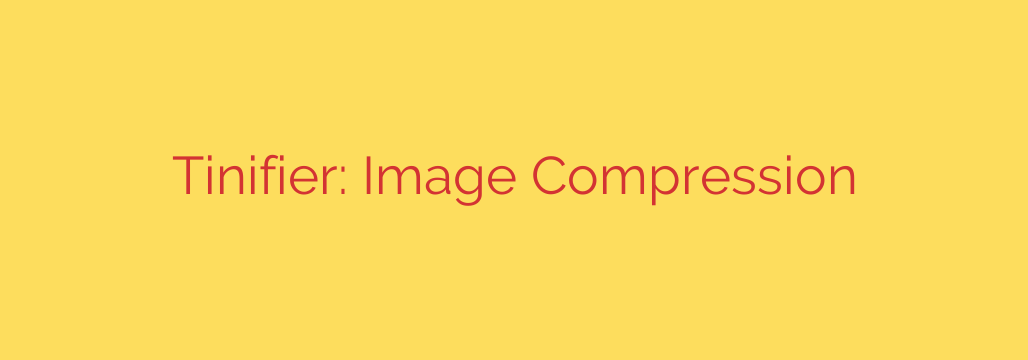
Unlock Faster Load Times: A Deep Dive into Tinifier for Image Compression
In today’s digital landscape, website speed isn’t just a luxury—it’s a necessity. Slow-loading pages can frustrate visitors, increase bounce rates, and negatively impact your search engine rankings. One of the biggest culprits behind a sluggish website? Large, unoptimized images. Fortunately, automating the image compression process has never been easier, and tools like Tinifier are leading the charge.
If you’re looking to enhance your site’s performance without a complicated manual workflow, understanding how to leverage automated image optimization is crucial.
What is Image Compression and Why Is It Essential?
Image compression is the process of reducing the file size of an image without significantly compromising its visual quality. Every high-resolution photo or graphic you upload to your site contains a large amount of data. While this data ensures the image looks sharp, it also requires more bandwidth to download, slowing down your page load time.
The benefits of effective image compression are clear and directly impact your bottom line:
- Improved User Experience (UX): Faster pages keep users engaged and more likely to explore your site.
- Better SEO Rankings: Google and other search engines use page speed as a key ranking factor. Faster sites often rank higher.
- Lower Bounce Rates: Visitors are less likely to leave your site out of frustration when pages load quickly.
- Reduced Bandwidth Costs: Smaller files consume less data, which can lower hosting and CDN costs.
Introducing Tinifier: Your Automated Optimization Solution
Tinifier is a powerful tool designed to integrate directly into your website’s content management system (CMS). It acts as a bridge between your media library and world-class compression services like TinyPNG and TinyJPG. Instead of manually optimizing every image before uploading, Tinifier automates the entire process behind the scenes.
When you upload a new image, Tinifier intercepts it, sends it to a compression engine, and replaces the original file with the newly optimized, smaller version. This all happens seamlessly in the background, saving your team valuable time and effort.
Key Benefits of Using Tinifier for Your Website
Implementing an automated solution like Tinifier provides several powerful advantages that go beyond just speed.
1. Drastically Improved Page Speed
This is the most significant benefit. By systematically reducing the file size of every image on your site, you directly cut down on the total page weight. Many users see a 50-70% reduction in image file sizes, leading to dramatically faster load times and better scores on performance tests like Google PageSpeed Insights.
2. Seamless and Automated Workflow
The “set it and forget it” nature of Tinifier is a game-changer for content creators and developers. There’s no need to train your team on using external tools or add extra steps to their publishing process. Images are optimized automatically upon upload, ensuring consistent performance across your entire site without any manual intervention.
3. Bulk Optimization for Existing Images
What about all the images already in your media library? Tinifier includes a bulk optimization feature that can crawl your existing content and compress every image it finds. This is an incredibly efficient way to retroactively improve the performance of your entire website without having to re-upload years of content.
4. Enhanced SEO Performance
Site speed is a confirmed ranking signal, and with Google’s focus on Core Web Vitals, having a fast, responsive site is more important than ever. By optimizing your images, you directly improve your Largest Contentful Paint (LCP) score, a key metric for user experience. A faster site leads to better rankings, more organic traffic, and higher conversions.
Actionable Tips for a Comprehensive Image Strategy
While a tool like Tinifier is incredibly powerful, it works best as part of a holistic image optimization strategy. Here are a few extra tips to ensure your visuals are working for you, not against you.
- Choose the Right File Format: Use JPEGs for photographs and complex images. Use PNGs for graphics that require a transparent background, like logos or icons. Consider modern formats like WebP for even better compression where browsers support it.
- Resize Images Before Uploading: Always resize your images to the actual dimensions they will be displayed at. There’s no reason to upload a 4000-pixel wide image if it will only ever be shown in a 800-pixel container. This is a crucial first step before compression.
- Leverage Lazy Loading: Implement lazy loading so that images below the fold (outside the user’s initial view) only load as the user scrolls down the page. This dramatically speeds up the initial page load.
By combining these best practices with an automated tool, you create a robust system that keeps your website fast, efficient, and user-friendly. Don’t let heavy images compromise your site’s potential.
Source: https://www.linuxlinks.com/tinifier-image-compression-tool/








